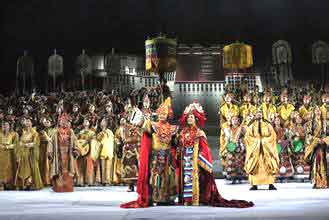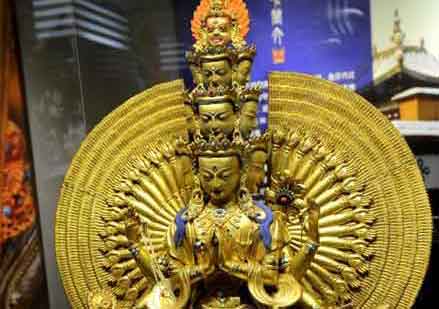Roundup: Tibet’s intangible culture heritage protection efforts pay off
Tibet boasts rich and time-honored cultural resources, including folk literature, traditional dance, Tibetan opera, art, and other intangible cultural legacies. Since Tibet has launched the protection project of its intangible cultural heritage, it has achieved remarkable results.
According to China Tibet News, currently Tibet has two UN Humanity Intangible Cultural Heritage representative works (Tibetan opera and the epic King Gesar), 89 national-level representative projects, 68 national-level representative cultural inheritors, 323 regional-level representative projects, 350 autonomous regional-level cultural inheritors, 109 prefecture(municipal)-level representative projects, and 1,153 county-level representative projects.
Since 2010, Tibet has published a series of books and audiovisual products on intangible cultural heritage. It has already published 100 books and audiovisual products such as “The History of Tibetan Opera”, “A Collection of the Tibetan Operas”, “Overview of Tibetan Folk Dances”, “Archive of Northern Tibet Gesar Performers”. In the meanwhile, Tibet has also digitized traditionally eight schools of Tibetan opera, Tibetan dance, the epic Gesar, as well as three kinds of Chamdo dances.
Jiji, head of Intangible Heritage Divisionof Tibet Culture department said that by the end of 2015, the Central Government had invested nearly 150 million yuan in protecting national intangible cultural heritage and supporting the national-level representative cultural inheritors.
In recent years, the Tibet Autonomous Region has funded more than 15 million yuan into the two UN projects, focusing on supporting the folk opera troupes and epic King Gesar performers, which has greatly raised the enthusiasm of the Tibetan opera and Gesar chanters across the region. Over the last two years, the number of folk Tibetan opera troupes has grown to 133, that of Tibetan opera performers to nearly 4,000, and that of the epic King Gesar chanters to early 100.
Jiji said that on March 31, 2014, the Tibet People’s Congress passed the “Tibet Autonomous Region Implementation Measures of ‘People’s Republic of China Intangible Cultural Heritage Law’”, and was officially enforced as of June 1 that year.
Tibet has also distributed notices, convened news conferences, and held training sessions and taken other measures to strengthen the spread of information, greatly enhancing the awareness of the general public of and the law-based administration of the local government in the protectioin intangible cultural heritage, according to Jiji.
Your Comment
Name E-mailRelated News
-
;
-
-

-
Tibet’s intangible cultural heritage experience park project laun
The Intangible Cultural Heritage Experience Park and “Princess Jincheng” indoor stage production project was launched in Lhasa on March 15.
-
-
-

-
100 cultural relics from Dalai Lamas' summer resort displayed in F
On March 16, 100 cultural relics were exhibited in Fujian Museum in southeast China's Fujian Province.
-
-
-

-
Tibet’s intangible cultural heritage experience park project laun
The Intangible Cultural Heritage Experience Park and “Princess Jincheng” indoor stage production project was launched in Lhasa on March 15.
-
-
-

-
100 cultural relics from Dalai Lamas' summer resort displayed in F
On March 16, 100 cultural relics were exhibited in Fujian Museum in southeast China's Fujian Province.
-
Based in Lhasa, Tibet Vista is a Tibet travel agency that specialized in Tibet permit, and Tibet tours for both private and group travelers at a local price!
•4 Days Lhasa City Group Tour from USD 460 •8 Days Everest Base Camp Group Tour from USD 850 •15 Days Mt.Kailash Group Tour from USD 1780 •2016 Tibet Train Tours from Beijing, Shanghai, Chengdu, Xining,etc










